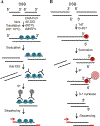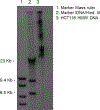Mapping DNA Breaks by Next-Generation Sequencing
- PMID: 29043624
- PMCID: PMC8057127
- DOI: 10.1007/978-1-4939-7306-4_13
Mapping DNA Breaks by Next-Generation Sequencing
Abstract
Here, we present two approaches to map DNA double-strand breaks (DSBs) and single-strand breaks (SSBs) in the genome of human cells. We named these methods respectively DSB-Seq and SSB-Seq. We tested the DSB and SSB-Seq in HCT1116, human colon cancer cells, and validated the results using the topoisomerase 2 (Top2)-poisoning agent etoposide (ETO). These methods are powerful tools for the direct detection of the physiological and pathological "breakome" of the DNA in human cells.
Keywords: DNA damage; Double-strand breaks (DSBs); Etoposide (ETO); Single-strand breaks (SSBs); Topoisomerase 2 (Top2).
Figures



Similar articles
-
DNA break mapping reveals topoisomerase II activity genome-wide.Int J Mol Sci. 2014 Jul 23;15(7):13111-22. doi: 10.3390/ijms150713111. Int J Mol Sci. 2014. PMID: 25056547 Free PMC article.
-
A nucleotide resolution map of Top2-linked DNA breaks in the yeast and human genome.Nat Commun. 2019 Oct 24;10(1):4846. doi: 10.1038/s41467-019-12802-5. Nat Commun. 2019. PMID: 31649282 Free PMC article.
-
Bioflavonoids cause DNA double-strand breaks and chromosomal translocations through topoisomerase II-dependent and -independent mechanisms.Mutat Res Genet Toxicol Environ Mutagen. 2020 Jan;849:503144. doi: 10.1016/j.mrgentox.2020.503144. Epub 2020 Jan 22. Mutat Res Genet Toxicol Environ Mutagen. 2020. PMID: 32087851 Free PMC article.
-
Exploring the SSBreakome: genome-wide mapping of DNA single-strand breaks by next-generation sequencing.FEBS J. 2021 Jul;288(13):3948-3961. doi: 10.1111/febs.15568. Epub 2020 Oct 2. FEBS J. 2021. PMID: 32965079 Review.
-
Type II DNA Topoisomerases Cause Spontaneous Double-Strand Breaks in Genomic DNA.Genes (Basel). 2019 Oct 30;10(11):868. doi: 10.3390/genes10110868. Genes (Basel). 2019. PMID: 31671674 Free PMC article. Review.
Cited by
-
Pim kinase inhibitor co-treatment decreases alternative non-homologous end-joining DNA repair and genomic instability induced by topoisomerase 2 inhibitors in cells with FLT3 internal tandem duplication.Oncotarget. 2021 Aug 31;12(18):1763-1779. doi: 10.18632/oncotarget.28042. eCollection 2021 Aug 31. Oncotarget. 2021. PMID: 34504649 Free PMC article.
-
Endogenous DNA Double-Strand Breaks during DNA Transactions: Emerging Insights and Methods for Genome-Wide Profiling.Genes (Basel). 2018 Dec 14;9(12):632. doi: 10.3390/genes9120632. Genes (Basel). 2018. PMID: 30558210 Free PMC article. Review.
-
DNA damage and repair in differentiation of stem cells and cells of connective cell lineages: A trigger or a complication?Eur J Histochem. 2021 May 3;65(2):3236. doi: 10.4081/ejh.2021.3236. Eur J Histochem. 2021. PMID: 33942598 Free PMC article. Review.
-
Genome-wide detection of DNA double-strand breaks by in-suspension BLISS.Nat Protoc. 2020 Dec;15(12):3894-3941. doi: 10.1038/s41596-020-0397-2. Epub 2020 Nov 2. Nat Protoc. 2020. PMID: 33139954
References
-
- Blitzblau HG, Hochwagen A (2011) Genome-wide detection of meiotic DNA double-strand break hotspots using single-stranded DNA. Methods Mol Biol 745:47–63 - PubMed
MeSH terms
Substances
Grants and funding
LinkOut - more resources
Full Text Sources
Other Literature Sources
Miscellaneous

